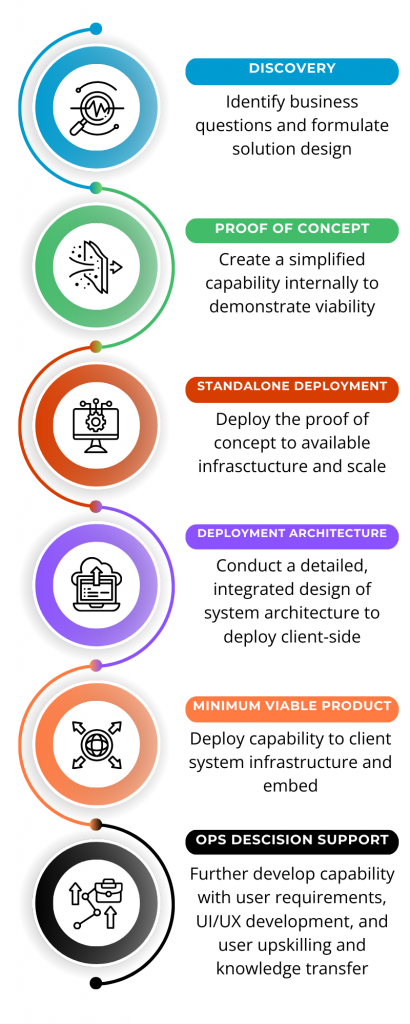
Chris Holmes Principal Consultant, Modelling
Following on from our blog on Simulation Modelling (read it here if you haven’t already), Chris Holmes, along with our Modelling and Data Science teams, have shifted the spotlight to ABM. This blog will cover the basics, when to use it and our approach to utilising it effectively within the Defence and Public Sectors.
ABM is a bottom-up simulation technique where we analyse a complex system by its individual “agents” that interact with each other. An agent is a self-contained element of the system being modelled – these agents could be individuals, organisations, or other entities capable of making decisions. Agents are programmed to behave and interact with other agents and the environment in particular ways using a set of rules.
This requires the ability to codify (define in a mathematical sense) the behaviours of the agents. These interactions produce emergent effects that may differ from the effects of the individual agents but are not programmed into the model. For example, we could measure the effect of traffic jams in a simulated traffic system with agents (vehicles) that follow simple road rules while navigating a network of roads.
ABM is a good paradigm when a system’s behaviour at a macro-level is not largely understood, but it is easy to define the behavioural characteristics of individual agents in the system. For example, during the COVID-19 pandemic, the impact of government strategies and the vaccination programme were not understood. ABM was used heavily to support decision-making when considering tactics like social distancing guidelines and the impact of enforcing lockdowns.
ABM is therefore a brilliant approach to use when there is limited data. By using what-if analysis, one can understand the expected performance of a system based on agent interactions. Validation of an ABM model can be challenging, which affects the confidence of people using the paradigm as a decision support tool.
The decision-making process is a crucial part of working in the Defence sector. Having the right tools and frameworks in place can improve the efficiency of the decision-making process by enabling a better understanding of complex systems, predicting outcomes of policies before their implementation, and showing a granular analysis of the impact of these policies on the system. Increasing numbers of problems being addressed by Defence organisations involve multiple different entities and a variety of goals that typically form complex systems.
In situations of high uncertainty and without historical data to adopt traditional optimisation and data science techniques, ABMs can offer a medium to gain insights into complex systems and processes. ABMs can be viewed as a testbed for finding emergent properties, trade-offs, and best-case outcomes. ABM simulations have been successfully applied to wargaming, where they equipped planners with counter-intuitive insights and optimal strategies.
In addition to wargaming, there are successful use cases of adopting ABMs to support decision-makers in training management, supply chain, and logistics management.
Techmodal has designed and implemented an ABM simulating interconnected pathways for training programs under different ‘what if’ scenarios. This provided long-term forecasts and helped our client enhance their understanding of the training pipelines, test policies in a controlled environment before their implementation, and uncover unintended consequences. The outputs of ABM also provide an opportunity for policymakers to engage stakeholders in the decision-making process.
We have also used ABM to assess the humanitarian aid requirements since the invasion of Ukraine. We achieved this by using Open-Source Intelligence (OSINT) to assess the demographics of Ukraine and the Media timeline of war-fighting. We then used this data to create an ABM simulating the migration of the civilian population within Ukraine. This provided a clear understanding of where it would be most practical and proper to position refugee camps and to access the potential aid suppliers needed to sustain these camps.
Figure 1: Techmodal’s approach to ABM

ABM is heavily utilised in traffic management and highways planning activities. As previously mentioned, ABM was used throughout the COVID-19 pandemic and government agencies such as the recently formed Health Security Agency (HSA), where they used simulation capabilities such as ABM to understand the risk of breakouts and biochemical attacks. ABMs are also used to support policy and decision-making for all levels of government.
Figure 1 illustrates how we work with and support our clients in the deployment and adoption of a Modelling decision support capability. Techmodal work with our clients to shape the capability and embed it within the organisation.
We are used to working with incomplete data, disparate systems, and diverse and separated teams. We also recognise when a specific approach may have challenges and limitations, and will always be open and honest in proposing a practical solution. Above all, we work to ensure the delivery of a solution that provides immediate value, is user-driven, and is integrated into business processes.
Keep an eye out for our next Modelling & Simulation themed blog post, where we will delve into the topic of increasing the availability of systems, equipment and other assets.


